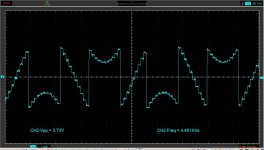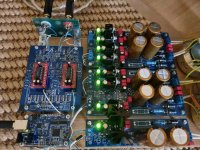Thanks. I think it is less interesting.The difference is that the new version also has isolation for I/O pins (A0-A3, Mute, ...).
For mute, it already has isolated mute if I remember correctly.
Some members here have reported hearing differences in sources through I2SoverUSB. Although I find those claims somewhat implausible one possible reason could be that the non-isolated I/O leaks noise to the downstream devices (DAC, Fifo, ...).
Hi,
can someone point me the link leading to the PCM63 gerber files for miro DAC please. I usually find what I search but not this time 🙁
Thanks.
Damien
can someone point me the link leading to the PCM63 gerber files for miro DAC please. I usually find what I search but not this time 🙁
Thanks.
Damien
Here
https://www.diyaudio.com/community/...s-input-nos-r-2r.354078/page-209#post-7049224
For future reference, miro has set his website link with all the projects here in the first post, all linked 🙂
https://www.diyaudio.com/community/...s-input-nos-r-2r.354078/page-209#post-7049224
For future reference, miro has set his website link with all the projects here in the first post, all linked 🙂
Yes, @djmilicic and I happened to notice the problem. PCM1702-K with an adapter for PCM63 in one DAC works, in the other it works but with crackling. It turns out that the problem is in the shift registers (AHCT & HCT). Later, a direct JLS I2S over USB connection was tried, bypassing the shift registers, and it works fine. PCM63 works with both types of shift registers. The screenshot shows what happens when the 1702 works with the AHCT registers (sine wave 1kHz). With HCT it works fine. I have no idea why it is like that.
We shopped parts at Mouser, there was a shortage of parts and we got the AHCT shift registers, because we know it works with PCM63 thanks to @mikorist who was a beta tester of PCM63.
We shopped parts at Mouser, there was a shortage of parts and we got the AHCT shift registers, because we know it works with PCM63 thanks to @mikorist who was a beta tester of PCM63.
Attachments
Last edited:
Direct connection example. The diode in the picture reduces the voltage for the XMOS part to about 4.2VDC. PCM1702 with adapter works on PCB for PCM63 with data from JLS board. I/V is passive (100ohm resistors). What is behind is the tube gain stage which is not visible. 🤣
Attachments
Another interesting thing. When the Miro PSUD2 PCB is cut in half (longitudinally), one complete plus and one complete minus regulator is obtained. The other two were lost. Thus, LT1963 or LT3015 can be used to power the XMOS part of the JLS card. Pictured above is the LT3015 (fixed -5V) with a larger heatsink. The point of cutting is the possibility of using a larger cooler and smaller PCB for one single 5V supply.
I have the Amanero and also Jlsound. They are both perfect working with Dac in Win10 and macOS. I prefer macOS (Big Sur currren) - she is better than Windows.What USB/I2S card is that? Does it work under Windows?
I have the Amanero and also Jlsound. They are both perfect working with Dac in Win10 and macOS. I prefer macOS (Big Sur current) - she is better than Windows.What USB/I2S card is that? Does it work under Windows?
100ohm is too much for PCM1702🙄Direct connection example. The diode in the picture reduces the voltage for the XMOS part to about 4.2VDC. PCM1702 with adapter works on PCB for PCM63 with data from JLS board. I/V is passive (100ohm resistors). What is behind is the tube gain stage which is not visible. 🤣
50 and below will be fine, 100 gives a soft sound, without kick and details in the middle, regardless of which tube is used
It's a pity to use PCM1702 like that and without a real I/V stage
Last edited:
I don't know why you are all stuck on passive I/V conversion. I struggled with this passive conversion for ten years and in the end I gave up, I tried everything, various lamps, etc. but the sound was always slow and blurry, especially in the middle tones where there is the most musical information.
I'm not saying that it gives a bad sound, but it can be better, especially with the PCM1702.
I'm not saying that it gives a bad sound, but it can be better, especially with the PCM1702.
Hello there,
Did someone has tried to follow this:
http://jlsounds.com/updates.html
I am using AD1862 driven by JLSound, so, to update I need to have driver V4.67 and it's corresponding DFU (i.e. 4.67).
Apparently, after updating the firmware the version becomes completely something else (became version 4.86).
The AD1862 is still working (up to X8).
Lyuben has mentioned to me this update might solve the X16 (I think to work with 20 bit word length?) but I do not succeed to follow the steps (as written) and of course I afraid to do everything with version 87. I am still waiting for Lyuben's answer but I thought maybe some of you have tried.
Thanks,
Guy
Did someone has tried to follow this:
http://jlsounds.com/updates.html
I am using AD1862 driven by JLSound, so, to update I need to have driver V4.67 and it's corresponding DFU (i.e. 4.67).
Apparently, after updating the firmware the version becomes completely something else (became version 4.86).
The AD1862 is still working (up to X8).
Lyuben has mentioned to me this update might solve the X16 (I think to work with 20 bit word length?) but I do not succeed to follow the steps (as written) and of course I afraid to do everything with version 87. I am still waiting for Lyuben's answer but I thought maybe some of you have tried.
Thanks,
Guy
Always update your board. I have. Also i have purchased the new version of his board, so we will see how that one fares (it will be used for tda1541a).
I really want to update but please read the PDF in the linked page.
If you want to update and work with AD1862 you need to first roll back to driver V.4.67
If you want to update and work with AD1862 you need to first roll back to driver V.4.67
100ohm is too much for PCM1702🙄
50 and below will be fine, 100 gives a soft sound, without kick and details in the middle, regardless of which tube is used
https://www.diyaudio.com/community/...st-tht-i2s-input-nos-r-2r.354078/post-7264825
Much better with 27R.
🤓
Patrick
- Home
- Source & Line
- Digital Line Level
- DAC AD1862: Almost THT, I2S input, NOS, R-2R


